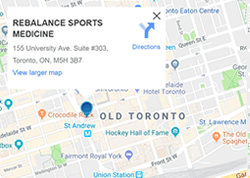ACL Tears: Causes, Symptoms, Treatment and Exercises
 “You have a torn ACL”. These are typically the last words an athlete ever wants hear. ACL stands for Anterior Cruciate Ligament which is one of the four main ligaments that stabilize the knee. In many medical circles it is considered the most important stabilizing ligament of the knee. When torn or injured it often means a long recovery period which could involve surgery or conservative therapies. Below you will find information on how this ligament gets injured, who is at increased risk, the approximate recovery times as well as rehab and prevention methods.
“You have a torn ACL”. These are typically the last words an athlete ever wants hear. ACL stands for Anterior Cruciate Ligament which is one of the four main ligaments that stabilize the knee. In many medical circles it is considered the most important stabilizing ligament of the knee. When torn or injured it often means a long recovery period which could involve surgery or conservative therapies. Below you will find information on how this ligament gets injured, who is at increased risk, the approximate recovery times as well as rehab and prevention methods.
Mechanism of ACL Injury
The Anterior Cruciate Ligament (ACL) is responsible for stopping your shin bone (tibia) from translating forward past your knee’s normal anatomical limits. The most common mechanism of injury is a cutting or pivot type of motion, where there is a sudden change of direction when the foot is planted. Other ways to injure your ACL includes improper landing techniques from a jump or fall, or a direct hit to the front of the knee. The vast majority of ACL injuries are non-contact with some studies showing up to as high as 75 to 80% being non-contact.
Grades of Ligament Sprains: (applicable to ACL)
Grade 1 – Ligament fibers are stretched with no tear. There is minimal tenderness or swelling and no instability.
Grade 2 – Ligament fibers are partially torn with moderate swelling and tenderness. Increased instability with anterior translation but still has a solid end point.
Grade 3 – Ligament fibers are completely torn, there is tenderness but normally minimal pain. Knee is unstable and no ligamentous end point is felt.
Who is at Risk of ACL Injuries?
ACL injuries have the highest chance of happening without physical contact and are normally caused by a type of twisting movement through the knee. They usually occur in fast paced sports with rapid changes in direction. The highest incidences are found in sports such as soccer, basketball, football and skiing. Other potential risk factors include footwear such as cleats on artificial turf. Additionally, weaknesses and imbalances to muscles surrounding the knee and hip are contributing factors.
Women possess up to 3 times greater risk for tearing their ACL than their male counterparts. The reason for this is that women have a wider pelvis and therefore have a greater angle from the top of the femur (thigh bone) down to their knee, known as the “Q” angle. This increased “Q” angle means hip stabilization and knee strengthening are going to be vital in preventing ACL injuries in female athletes. Furthermore, women tend to have more ligament laxity (mobile joints) as compared to males which can also predispose a female to higher chances of injury.
ACL Recovery Time
Once the grade of ACL tear is determined, a proper recovery protocol and timeframe for rehab can be given. In general, a grade 1 or 2 sprain of the ACL can take from a few weeks to a couple months to properly heal. These usually do not require surgical intervention and conservative therapies are recommended. If you have a grade 3 tear however the recovery time is much longer because now there is a decision to make, which is, do I need surgery? With or without surgery it can be approximately 6-12 months before return to sports.
Rehab and Prevention of ACL Tears
Rehab for ACL tears is commonly centered on first reducing symptoms of pain and swelling. Following this achieving full range of motion is normally next on the agenda. While your health care practitioner is working on increasing the range they will also work with you on building strength and improving your balance. There are many medical protocols that exist for recovery but in general the process will involve corrective exercises, muscle stimulation, acupuncture, ultrasound, aquatic therapy, biking and other methods to speed along the recovery times.
To prevent ACL injuries in the first place it is highly recommended to work with a qualified therapist and trainer in areas of strength, balance, jump and agility training and stretching.
If you already have an existing ACL injury and need additional information about your options, please speak to any of our highly trained Physiotherapists, Chiropractors, or Sports Medicine Doctors at Rebalance Sports Medicine.
Dr. Chad Carter, Chiropractor
Dr. Chad Carter is a chiropractor practicing at Rebalance Sports Medicine in downtown Toronto.



 What to Expect From Your First Physiotherapy Visit
What to Expect From Your First Physiotherapy Visit The Benefits of Fascial Stretch Therapy [Demo]
The Benefits of Fascial Stretch Therapy [Demo] How Does Physiotherapy Work?
How Does Physiotherapy Work? Best Exercises for Low Back Pain
Best Exercises for Low Back Pain